Abstract
We made longitudinal measurements of bone mineral density (BMD) in 139 normal women (ages 20-88 yr) at midradius (99% cortical bone) and lumbar spine (approximately 70% trabecular bone) by single- and dual-photon absorptiometry. BMD was measured 2-6 (median, 3) times over an interval of 0.8-3.4 yr (median, 2.1 yr). For midradius, BMD did not change (+0.48%/yr, NS) before menopause but decreased (-1.01%/yr, P less than 0.001) after menopause. For lumbar spine, there was significant bone loss both before (-1.32%/yr, P less than 0.001) and after (-0.97%/yr, P = 0.006) menopause; these rates did not differ significantly from each other. Our data show that before menopause little, if any, bone is lost from the appendicular skeleton but substantial amounts are lost from the axial skeleton. Thus, factors in addition to estrogen deficiency must contribute to pathogenesis of involutional osteoporosis in women because about half of overall vertebral bone loss occurs premenopausally.
Full text
PDF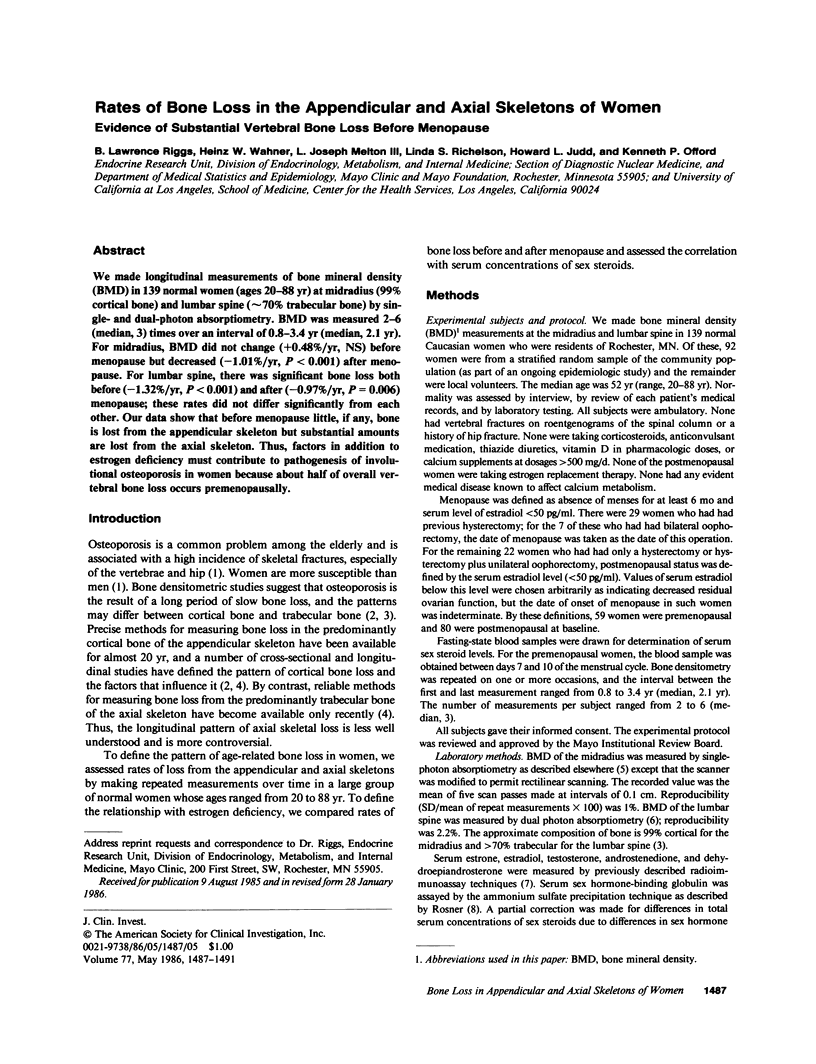
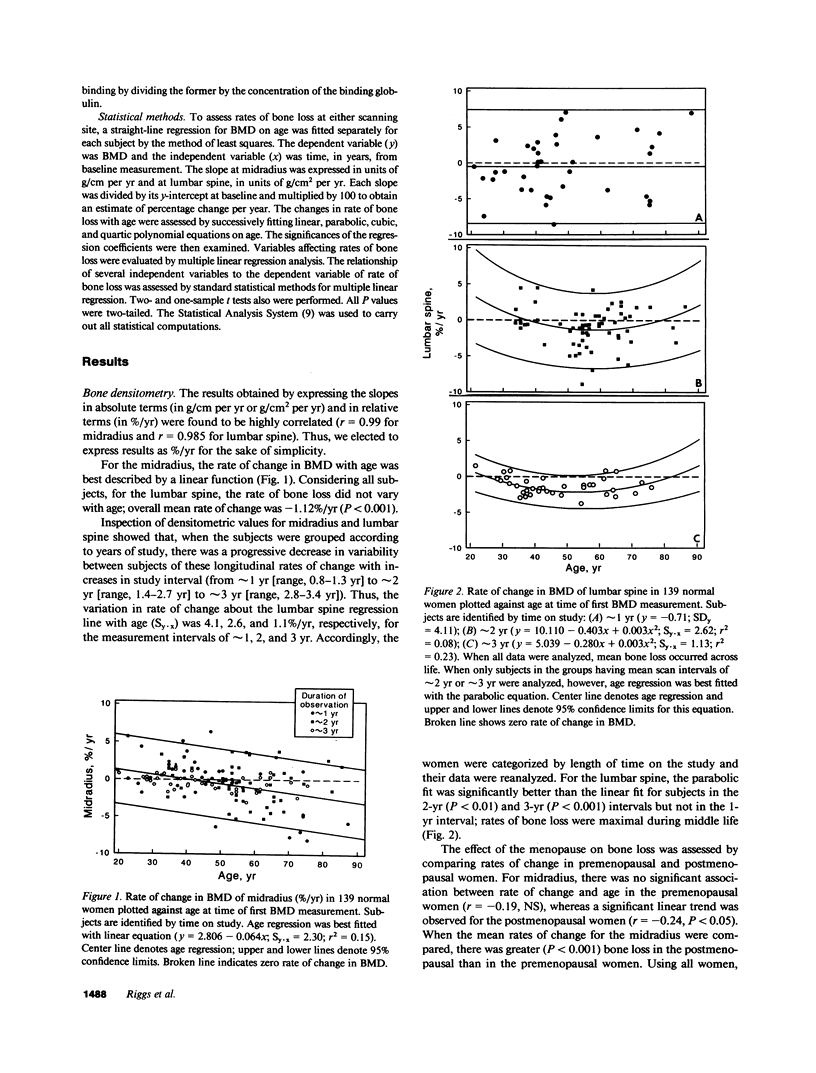
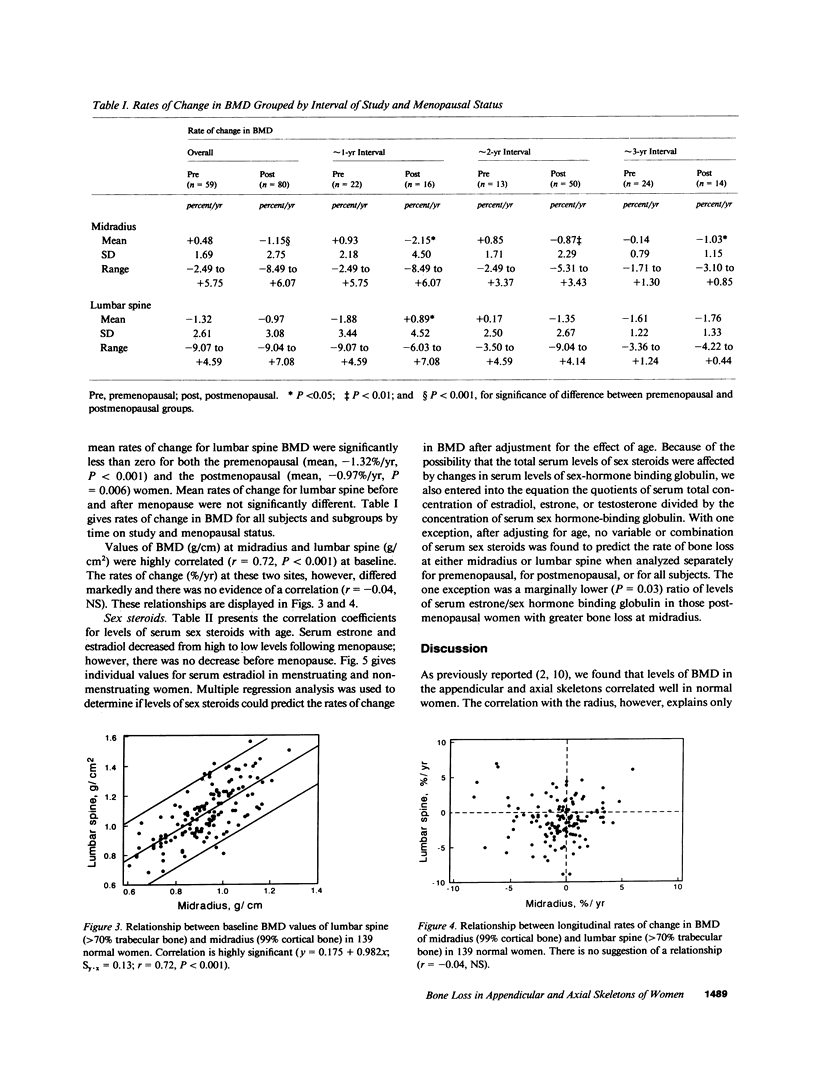
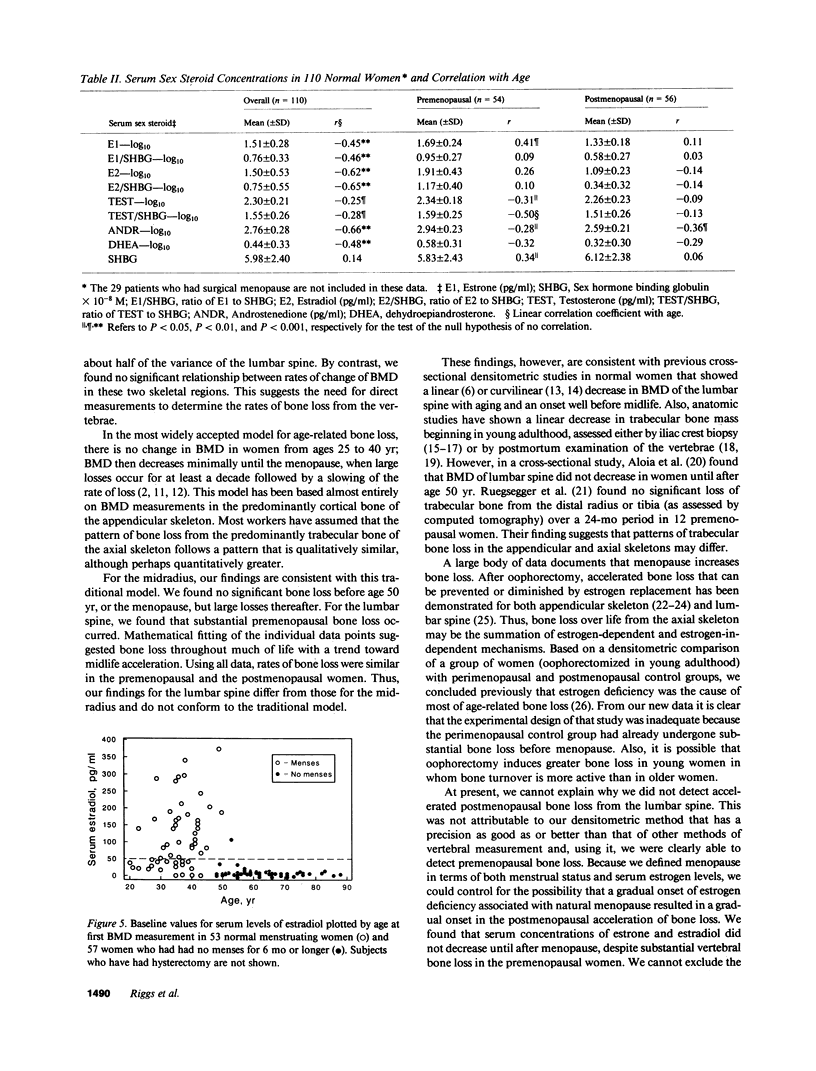
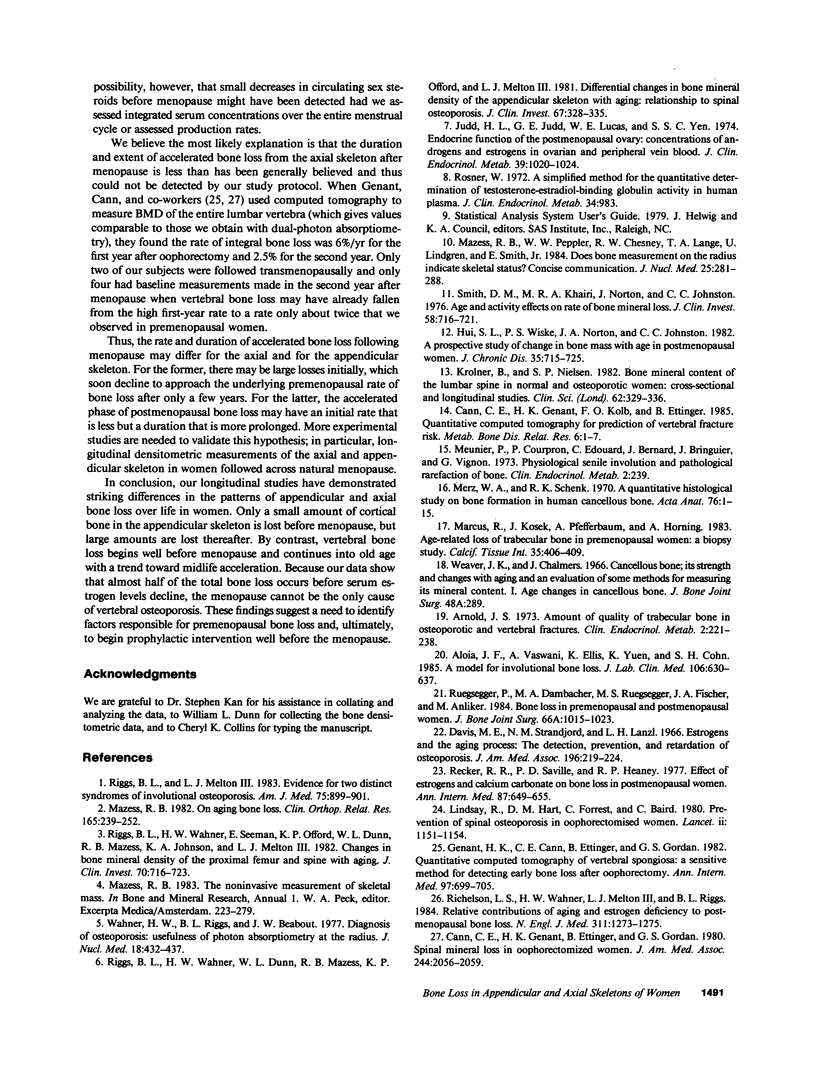
Selected References
These references are in PubMed. This may not be the complete list of references from this article.
- Aloia J. F., Vaswani A., Ellis K., Yuen K., Cohn S. H. A model for involutional bone loss. J Lab Clin Med. 1985 Dec;106(6):630–637. [PubMed] [Google Scholar]
- Arnold J. S. Amount and quality of trabecular bone in osteoporotic vertebral fractures. Clin Endocrinol Metab. 1973 Jul;2(2):221–238. doi: 10.1016/s0300-595x(73)80041-6. [DOI] [PubMed] [Google Scholar]
- Cann C. E., Genant H. K., Ettinger B., Gordan G. S. Spinal mineral loss in oophorectomized women. Determination by quantitative computed tomography. JAMA. 1980 Nov 7;244(18):2056–2059. [PubMed] [Google Scholar]
- Cann C. E., Genant H. K., Kolb F. O., Ettinger B. Quantitative computed tomography for prediction of vertebral fracture risk. Bone. 1985;6(1):1–7. doi: 10.1016/8756-3282(85)90399-0. [DOI] [PubMed] [Google Scholar]
- Davis M. E., Lanzl L. H., Strandjord N. M. Estrogens and the aging process. The detection, prevention, and retardation of osteoporosis. JAMA. 1966 Apr 18;196(3):219–224. [PubMed] [Google Scholar]
- Genant H. K., Cann C. E., Ettinger B., Gordan G. S. Quantitative computed tomography of vertebral spongiosa: a sensitive method for detecting early bone loss after oophorectomy. Ann Intern Med. 1982 Nov;97(5):699–705. doi: 10.7326/0003-4819-97-5-699. [DOI] [PubMed] [Google Scholar]
- Hui S. L., Wiske P. S., Norton J. A., Johnston C. C., Jr A prospective study of change in bone mass with age in postmenopausal women. J Chronic Dis. 1982;35(9):715–725. doi: 10.1016/0021-9681(82)90095-9. [DOI] [PubMed] [Google Scholar]
- Judd H. L., Judd G. E., Lucas W. E., Yen S. S. Endocrine function of the postmenopausal ovary: concentration of androgens and estrogens in ovarian and peripheral vein blood. J Clin Endocrinol Metab. 1974 Dec;39(6):1020–1024. doi: 10.1210/jcem-39-6-1020. [DOI] [PubMed] [Google Scholar]
- Krølner B., Pors Nielsen S. Bone mineral content of the lumbar spine in normal and osteoporotic women: cross-sectional and longitudinal studies. Clin Sci (Lond) 1982 Mar;62(3):329–336. doi: 10.1042/cs0620329. [DOI] [PubMed] [Google Scholar]
- Lindsay R., Hart D. M., Forrest C., Baird C. Prevention of spinal osteoporosis in oophorectomised women. Lancet. 1980 Nov 29;2(8205):1151–1154. doi: 10.1016/s0140-6736(80)92592-1. [DOI] [PubMed] [Google Scholar]
- Marcus R., Kosek J., Pfefferbaum A., Horning S. Age-related loss of trabecular bone in premenopausal women: a biopsy study. Calcif Tissue Int. 1983 Jul;35(4-5):406–409. doi: 10.1007/BF02405068. [DOI] [PubMed] [Google Scholar]
- Mazess R. B. On aging bone loss. Clin Orthop Relat Res. 1982 May;(165):239–252. [PubMed] [Google Scholar]
- Mazess R. B., Peppler W. W., Chesney R. W., Lange T. A., Lindgren U., Smith E., Jr Does bone measurement on the radius indicate skeletal status? Concise communication. J Nucl Med. 1984 Mar;25(3):281–288. [PubMed] [Google Scholar]
- Merz W. A., Schenk R. K. A quantitative histological study on bone formation in human cancellous bone. Acta Anat (Basel) 1970;76(1):1–15. doi: 10.1159/000143476. [DOI] [PubMed] [Google Scholar]
- Meunier P., Courpron P., Edouard C., Bernard J., Bringuier J., Vignon G. Physiological senile involution and pathological rarefaction of bone. Quantitative and comparative histological data. Clin Endocrinol Metab. 1973 Jul;2(2):239–256. doi: 10.1016/s0300-595x(73)80042-8. [DOI] [PubMed] [Google Scholar]
- Recker R. R., Saville P. D., Heaney R. P. Effect of estrogens and calcium carbonate on bone loss in postmenopausal women. Ann Intern Med. 1977 Dec;87(6):649–655. doi: 10.7326/0003-4819-87-6-649. [DOI] [PubMed] [Google Scholar]
- Richelson L. S., Wahner H. W., Melton L. J., 3rd, Riggs B. L. Relative contributions of aging and estrogen deficiency to postmenopausal bone loss. N Engl J Med. 1984 Nov 15;311(20):1273–1275. doi: 10.1056/NEJM198411153112002. [DOI] [PubMed] [Google Scholar]
- Riggs B. L., Melton L. J., 3rd Evidence for two distinct syndromes of involutional osteoporosis. Am J Med. 1983 Dec;75(6):899–901. doi: 10.1016/0002-9343(83)90860-4. [DOI] [PubMed] [Google Scholar]
- Riggs B. L., Wahner H. W., Dunn W. L., Mazess R. B., Offord K. P., Melton L. J., 3rd Differential changes in bone mineral density of the appendicular and axial skeleton with aging: relationship to spinal osteoporosis. J Clin Invest. 1981 Feb;67(2):328–335. doi: 10.1172/JCI110039. [DOI] [PMC free article] [PubMed] [Google Scholar]
- Riggs B. L., Wahner H. W., Seeman E., Offord K. P., Dunn W. L., Mazess R. B., Johnson K. A., Melton L. J., 3rd Changes in bone mineral density of the proximal femur and spine with aging. Differences between the postmenopausal and senile osteoporosis syndromes. J Clin Invest. 1982 Oct;70(4):716–723. doi: 10.1172/JCI110667. [DOI] [PMC free article] [PubMed] [Google Scholar]
- Rosner W. A simplified method for the quantitative determination of testosterone-estradiol-binding globulin activity in human plasma. J Clin Endocrinol Metab. 1972 Jun;34(6):983–988. doi: 10.1210/jcem-34-6-983. [DOI] [PubMed] [Google Scholar]
- Ruegsegger P., Dambacher M. A., Ruegsegger E., Fischer J. A., Anliker M. Bone loss in premenopausal and postmenopausal women. A cross-sectional and longitudinal study using quantitative computed tomography. J Bone Joint Surg Am. 1984 Sep;66(7):1015–1023. [PubMed] [Google Scholar]
- Smith D. M., Khairi M. R., Norton J., Johnston C. C., Jr Age and activity effects on rate of bone mineral loss. J Clin Invest. 1976 Sep;58(3):716–721. doi: 10.1172/JCI108518. [DOI] [PMC free article] [PubMed] [Google Scholar]
- Wahner H. W., Riggs B. L., Beabout J. W. Diagnosis of osteoporosis: usefulness of photon absorptiometry at the radius. J Nucl Med. 1977 May;18(5):432–437. [PubMed] [Google Scholar]
- Weaver J. K., Chalmers J. Cancellous bone: its strength and changes with aging and an evaluation of some methods for measuring its mineral content. J Bone Joint Surg Am. 1966 Mar;48(2):289–298. [PubMed] [Google Scholar]


